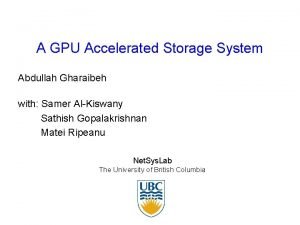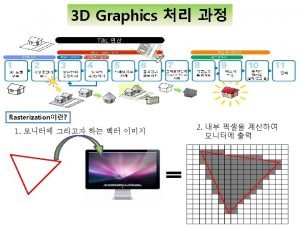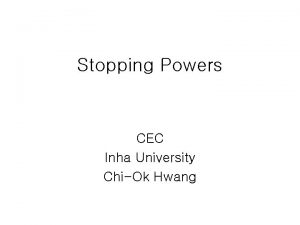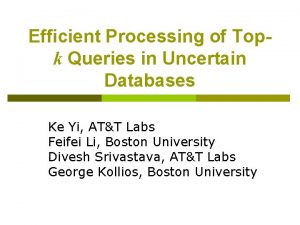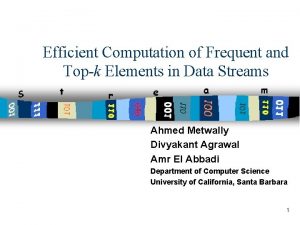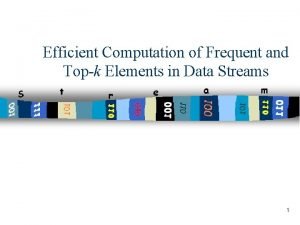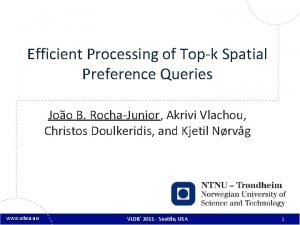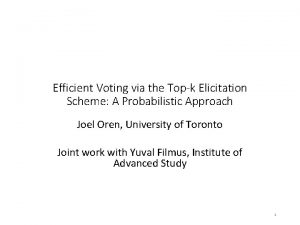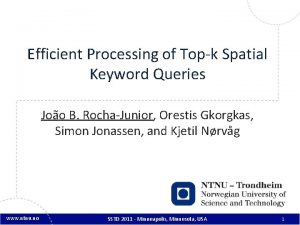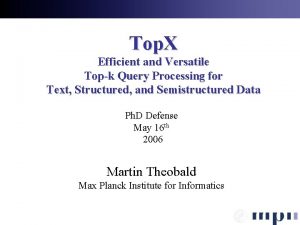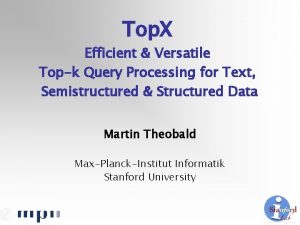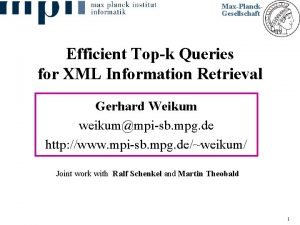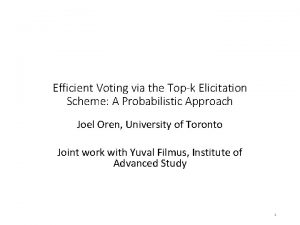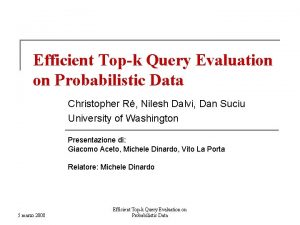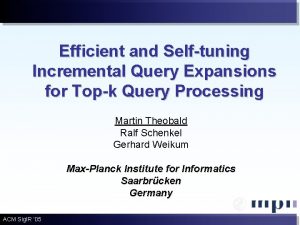GPU Accelerated TopK Selection With Efficient Early Stopping





















- Slides: 21

GPU Accelerated Top-K Selection With Efficient Early Stopping Vasileios Zois, Vassilis J. Tsotras, and Walid A. Najjar Department of Computer Science & Engineering University of California, Riverside Presented By Pritom Ahmed Department of Computer Science & Engineering University of California, Riverside ADMS 2019 – Monday, August 26 th

Outline 1. Overview of Top-K Selection Operator 2. GPU Processing Challenges & Top-K Selection For GPUs 3. GPU Accelerated Top-K Selection With Support For Early Termination 4. Experimental Evaluation of Proposed Solutions 2

Top-k Queries Motivation • Information Retrieval v Data object: an information entity characterized by a set of features/attributes v Examples: Documents, Images, Videos, Time Series, Objects, Tweets v Users are interested in objects that may partially match their query specification v Ranking based on relevance is pivotal to multi-criteria decision making applications. • Top-k Selection Problem v Enabling support for Top-K queries on database management systems v Use indexes to retrieve and evaluate only few tuples. v Terminate processing early and return the exact solution. v Support different monotone aggregation functions and query weights. 3

Top-K Selection Operator • Definition v Retrieve the K-highest ranking tuples from a given relation based on user-define monotone function. v Example: What are the Top-2 cars with the highest mpg and warranty? Make Model Warranty MPG Toyota Prius 15 50 Ford Mustang 10 10 BMW M 3 12 14 VW Jetta 10 30 Volvo XC 60 18 27 Hyundai Accent 15 25 Preference vector weights. 4

Top-K Query Evaluation (Naïve Approach) • 5

GPU Processing Challenges • Rigid Computation Model v Avoid thread divergence to improve processing throughput v Improve bandwidth utilization a) Avoid shared memory bank conflicts b) Enable coalesced memory access to global memory • Limited Main Memory Capacity v Unified memory support extends total memory capacity. v GPU driver is responsible for facilitating data movement. v Copying data through PCIe remains very costly. Registers SMEM/ L 1 … Registers SMEM/ L 1 L 2 Cache Device Memory PCIe (x 16) Host Memory Host Processor 6

• Algorithm Attributes Bitonic Top-K Selection Tuples 7 1 5 8 12 9 0 1 1 10 8 6 4 3 5 5 6 3 7 5 9 0 3 1 2 0 1 1 1 4 11 9 8 1 1 1 3 6 28 3 Score Aggregation 1. Evaluate the provided monotone function for every tuple. 13 29 2 24 Step 1 2. Split data into k-size groups. 12 14 21 4 Local Sort/ Bitonic Top – K Merge 29 13 2 29 14 24 Step 2 29 24 14 29 24 28 12 14 24 21 4 3 21 6 28 3 6 3. Perform bitonic sort for k-iterations. 4. Merge adjacent groups and retain only the k-highest ranked tuple. 5. Repeat steps 3 and 4 until only k tuples remain. *Shanbhag, 6 21 A. , et al. “Efficient Top-K query processing on massively parallel hardware”. SIGMOD, 2018. 28 7 28

Bitonic Top-K Selection Performance Characteristics • Positive Characteristics v Performs better than sorting by avoiding the associated scatter writes into global memory. v Enables high parallelism and coalesced memory accesses. v Avoids shared memory bank conflicts. • Negative Characteristics v Table scan evaluates the query attributes of every tuple. v Performance limited by the available global memory bandwidth. v When memory capacity is low, query evaluation is expensive because the data associated with target relation need to be fetched directly from host memory. • Proposed solution v Leverage on early termination to reduce the overall memory access cost host/device memory. v Retain the benefits of bitonic Top-K during score evaluation. 8

Prior Work on Top-K Selection • 9

List-Based Early Termination • Sorted-List Based Processing 1. Calculate score for each seen object. 2. Keep track of highest ranking objects. 3. Calculate threshold for each list level. • Terminate Processing v Compare threshold with minimum object score. v Stop when threshold lesser or equal. • Drawbacks v Too many random accesses. v Low parallelism. 10

GPU Threshold Algorithm (GTA) • 11

Partitioning Strategies • Angle Space Partitioning • Random Partitioning v Evenly distribute tuples according to insert order. v Pre-processing overhead is almost zero. v Weak attribute correlation for tuples in same partition. Random Partitioning 1 v Apply grid partitioning on polar coordinates. v Higher pre-processing overhead. v Strong attribute correlation between tuples in the same partition. 1 0. 8 0. 6 0. 4 0. 2 0. 4 0. 6 0. 8 Angle Space Partitioning 1 0 0. 2 0. 4 0. 6 0. 8 1 12

Experimental Setup • Algorithms v GFTE (GPU Full Table Evaluation) v GTA – RP (using random partitioning). v GTA – ASP (using angle space partitioning). • Dataset & Preference Vector v Synthetic data containing correlated, independent and anti-correlated attributes. v Evaluated proposed method robustness on different preference vectors. • Application Paradigms v Data reside in device memory and no data transfers occur during query evaluation. v Data reside in host memory 1. Zero copy – data are transferred on demand during query evaluation. 2. Prefetching – a small portion of the data are transferredl before query evaluation. 13

Initial Cost of Pre-Ordering & Partitioning • Characteristics v Data partitioning and pre-ordering is performed only once. v Performed by the GPU using sorting and stream compaction. v ODT table organization resembles that of a clustered B-tree. v It can support insert/update/delete with small overhead. v. Both RP and ASP execute on top of pre-ordering. • Partitioning Performance Comparison v GTA – ASP incurs higher initialization cost. v In the worst case is at most 2 x worse than GTA – RP. v Not bad considering GTA-ASP enables 2 x to 200 x better query latency. 14

Variable Preference Vectors • Query Weight Characteristics v Five synthetically generated query weights. v Applied on independent data for different sub-query combinations. • Performance v No differences in latency for random partitioning. v ASP exhibits better performance on Q 0, Q 1, Q 4 v Overall ASP has as well a stable performance. 15

Device Memory Latency • Observations v Overall GFTE performs worse than any GTA variant. v Happens because it evaluates every tuple. • Increasing attributes v Fixed result size (k = 16). v GTA-RP better only on correlated and independent data. v GTA-ASP better across all distributions. • Increasing result size v v Fixed attribute number (d = 8). GTA-ASP better on correlated/independent data. Large k puts pressure on shared memory resources. GTA-ASP at least 2 x better on anticorrelated data. 16

Host Memory Latency • Zero copy v v • Prefetch Transfer data when kernel is called. GFTE transfers the complete relation. GTA variants transfer portion of the relation. Communication cost added to query evaluation. v v Provide hint to the driver to transfer portion of the data. GFTE better latency for 2/3 attributes (cached data). GTA variants fetch less tuples during query evaluation. GTA-ASP evaluates/retrieves less tuples on anticorrelated data. 17

CPU Performance Comparison • CPU Implementation v. Full table evaluation + multi-threading + SIMD (CFTE). v. Early termination + ASP + multi-threading + SIMD (CTA – ASP). • GPU Implementation v Proposed solutions operating on device memory resident data. • Performance Observations v Early termination works better than full evaluation. v Performance improvement proportional to GPU results. 18

Questions? ! 19

GTA Complexity • 20

GTA Complexity • Behavior v For random partitioning the evaluation region grows rapidly v For ASP it is restricted by the partition boundaries. v Hence ASP is expected to evaluated less tuples overall. 21
 Abdullah gharaibeh
Abdullah gharaibeh C b a d
C b a d Productively efficient vs allocatively efficient
Productively efficient vs allocatively efficient Productively efficient vs allocatively efficient
Productively efficient vs allocatively efficient Allocative efficiency vs productive efficiency
Allocative efficiency vs productive efficiency Allocative efficiency
Allocative efficiency Early stopping
Early stopping Early cpr and early defibrillation can: *
Early cpr and early defibrillation can: * Early selection psychology
Early selection psychology Similarities
Similarities K selection r selection
K selection r selection 5 points of natural selection
5 points of natural selection Mass selection
Mass selection K selection r selection
K selection r selection Natural selection vs artificial selection
Natural selection vs artificial selection Natural selection vs artificial selection
Natural selection vs artificial selection Two way selection and multiway selection
Two way selection and multiway selection Balancing selection vs stabilizing selection
Balancing selection vs stabilizing selection Artificial selection vs natural selection
Artificial selection vs natural selection Two way selection and multiway selection in c
Two way selection and multiway selection in c Stopping by woods on a snowy evening simile
Stopping by woods on a snowy evening simile What law of motion controls stopping distance?
What law of motion controls stopping distance?
